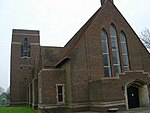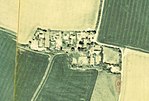Shorncliffe Redoubt
Forts in KentMilitary history of KentNapoleonic war forts in EnglandRedoubtsRifle Brigade (Prince Consort's Own) ... and 1 more
Use British English from November 2011

Shorncliffe Redoubt is a British Napoleonic earthwork fort. The site is approximately 300 feet by 300 feet and is situated on the Kentish Coast in Sandgate, Kent.
Excerpt from the Wikipedia article Shorncliffe Redoubt (License: CC BY-SA 3.0, Authors, Images).Shorncliffe Redoubt
Hospital Hill, Folkestone and Hythe District Coolinge
Geographical coordinates (GPS) Address Nearby Places Show on map
Geographical coordinates (GPS)
| Latitude | Longitude |
|---|---|
| N 51.075555555556 ° | E 1.1294444444444 ° |
Address
Shorncliffe Redoubt
Hospital Hill
CT21 5FB Folkestone and Hythe District, Coolinge
England, United Kingdom
Open on Google Maps








